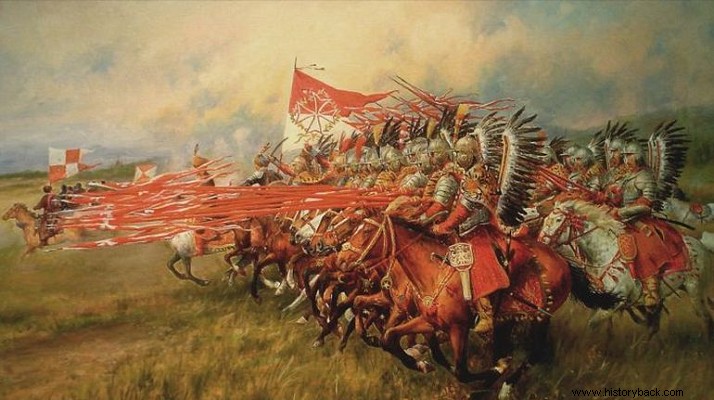
The Battle of Khotyn was fought in what is now Ukraine between Poles and Turks., on November 11, 1673. The Polish-Lithuanian Commonwealth was a powerful force in Eastern Europe in the 17th century, being almost constantly at war with the Ottomans. In 1672 the Ottoman army under Sultan Mehmet IV invaded the Polish lands in Podolia (western Ukraine) crushing unprepared Polish forces.
The humiliating defeats that followed roused the Poles, who entrusted the command to General John Sobieski, who was to ascend the Polish throne and save, in 1683, Vienna. In 1673 Sobieski at the head of about 30,000 men moved against the Turks.
Sobieski had 12 isles of the famous "Winged Hussars" with a total of 1,690 men, 3 isles of cavalry carabinieri with 342 men, 109 isles of "Pantserni" (=armoured) cavalry with 11,055 men, another 1,619 Vlach cavalry, 8,000 regular infantry, 500 irregular infantry, 19 companies of dragoons (mounted infantry) with a total strength of 5,828 men and 65 guns.
Hussein Pasha's Turkish forces had about the same number of men and 120 guns. Also the Turks had created a fortified camp on the Dniester River, awaiting the Polish attack there with their backs covered by the great river.
On November 10, the Poles arrived in the area of Hotin and began shelling the Turkish positions. The Turkish fortified camp had the shape of a semicircle. The Poles deployed their infantry and artillery in front keeping their cavalry in reserve. The bulk of their forces were drawn up on the southern side of the Turkish camp.
Accordingly, Hussein Pasha had arranged infantry and artillery in the fortifications, keeping his cavalry in reserve. The Turks were also followed by some Moldavians, but they left them before the Polish raid took place.
Attack
On the afternoon of November 10, the Poles attempted a first raid which failed. Sobieski did not persist. During the night, however, he got closer to the Turkish fortifications. The Turks became aware of the Poles' movement and prepared for a night raid. But Sobieski did not attack.
The night was freezing and soon it started to snow. Sobieski spent the whole night inspecting the Turkish fortifications and talking with his men. On the other side, the Turks, unable to bear the severe cold, slowly withdrew from the fortifications and found shelter in their tents. At 07.00 in the morning Sobieski gave the order to attack.
He himself, sword in hand, put himself in charge, reaching 20 m from the Turkish positions. From there he directed the attack. The Polish infantry and dragoons overthrew the Turks on the ramparts and entered the enemy camp. At the same time, passages were opened for the cavalry.
Hussein Pasha ordered his cavalry to counterattack. The battle between the tents developed into a wild, confused conflict. The Turkish cavalry could not act in concentration with the panic-stricken infantry and tents in front of them. Soon the situation for the Turks became tragic. The Polish cavalry entered the camp largely intact and destroyed, literally, everything in front of them.
Panicked, the Turks turned towards the Dniester with the opposite bank of which their camp communicated with a floating bridge. Other Turkish forces attempted to escape through the northern gates of the camp. There, however, they encountered Polish reserve units and were overturned.
The Bosnian horsemen of the Turkish army at the same time launched a swift counter-attack and almost turned the tide. But the famous "winged hussars", who, contrary to what their name suggests, were elite heavy horsemen, counterattacked and crushed them. At the same time, the Lithuanians attempted to capture the bridge and cut off the Turks' escape route.
Sobieski brought forward artillery and bombarded the bridge. About 5,000 Turkish horsemen managed to escape, fighting against the Lithuanians. But then the bridge was collapsed by the Polish guns and a massacre of the trapped Turks followed. The janissaries, 8,000 in all, were massacred to one. As many brave horsemen were killed or wounded, along with another 4,000 foot and horsemen.
The Polish army had 2,000 casualties. On the contrary, the Turks lost 20,000 men. Hussain escaped. But many of his high-ranking officers were killed. The battle lasted only 2 hours. Two days later and the fortified city of Hotin was surrendered to the victors.


